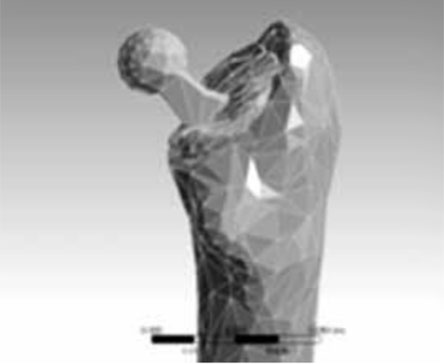Determination of the effect on the proximal femoral load distribution of diaphyseal cement support in femoral intertrochanteric fractures with calcar defect by finite element analysis
Dr. Hakan Çift
Dr. Serdar Deniz
Dr. Fatih Ekşioğlu
Medipol Üniversitesi Tıp Fakültesi Hastanesi, Ortopedi ve Travmatoloji Anabilim Dalı, İstanbul, Türkiye
Tokat Erbaa Devlet Hastanesi, Ortopedi ve Travmatoloji Kliniği, Tokat, Türkiye
Koru Hastanesi, Ortopedi ve Travmatoloji Kliniği, Ankara, Türkiye
Amaç: Bu çalışmada, kalkar femoris defektli intertrokanterik kırıklarda kalkar destekli protezlere alternatif olarak diafizer çimento desteği ile kombine yapılan artroplastilerde femur üst ucundaki yük dağılımının sonlu eleman analizi yöntemiyle sanal ortamda, biyomekanik olarak olumlu ve olumsuz yönleri araştırıldı.
Gereç ve yöntemler: ANSYS yöntemi ile üç adet femur modeli oluşturuldu. Bunlar kalkar defektsiz intertrokanterik kırık modeli, kalkar defektli kalın çimento mantolu intertrokanterik kırık modeli ve kalkar defektli ince çimento mantolu intertrokanterik kırık modeli olarak adlandırıldı. Sonlu element analizi ortamında yük dağılımları için iki bölge incelendi. Birincisi tüm femur, diğeri ise trokanter minörden başlayıp distal 5 cm’lik kısma uzanan bölge idi.
Bulgular: Kalkar defektsiz trokanterik kırık modelinde tüm femurda stres değerleri 22.9 MPa, trokanter minörden başlayıp 5 cm’lik bölgede 29.2 MPa olarak bulundu. Stres değerleri, kalkar defektli kalın çimento mantolu intertrokanterik kırık modelinde 23.6-29.9 MPa, kalkar defektli ince çimento mantolu intertrokanterik kırık modelinde ise 24.2-32.1 MPa idi. İstatistiksel analiz t-test ile yapıldı ve tümünde p değeri >0.005 olarak bulundu.
Sonuç: Çalışma bulgularımız, kalkar bölgesi defektli intertrokanterik kırıklarda, bu bölgenin kemik çimentosu ile şekil verilip bir çeşit kalkar oluşturulması ile yapılacak olan hemiartroplasti ameliyatında çimento/kemik bileşkesinde daha fazla stres oluşturmadığını gösterdi. Anahtar sözcükler: Çimento; femur intertrokanterik kırık; sonlu element analizi.
Objectives: This study aims to investigate biomechanically positive and negative aspects of arthroplasties in combination with diaphyseal cement support as an alternative to calcar supported prosthesis on the proximal femoral load distribution, using finite element analysis method in a virtual environment in intertrochanteric fractures with calcar femoral defect.
Materials and methods: Three femur models were created using the ANSYS method. These were named as a intertrochanteric fracture model without calcar defect, an intertrochanteric fracture model with thick cement mantle and calcar defect, and an intertrochanteric fracture model with thin cement mantle and calcar defect. In the finite element analysis setting, two regions were analyzed for load distributions. The first one was the whole femur, while the other one was the region starting from trochanter minor and extending distally to the 5 cm area.
Results: In the trochanteric fracture model without calcar defect, the stress value in the whole femur was found to be 22.9 MPa; whereas it was 29.2 MPa in the 5 cm long section starting at the trochanter minor. The stress values were 23.6-29.9 MPa in the intertrochanteric fracture model with thick cement mantle and 24.2-32.1 MPa in the intertrochanteric fracture model with thin cement mantle and calcar defect. The statistical analysis was performed using t-test and a p value of >0.005 was found in all.
Conclusion: Our study results showed that forming a type of calcar to be used in a hemiarthroplasty surgery and shaping of this region with bone cement does not produce further stress on the cement/bone intersection in intertrochanteric fractures with defected calcar region. Key words: Cement; femur intertrochanteric fracture; finite element analysis.

